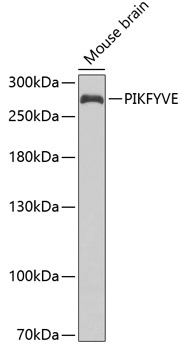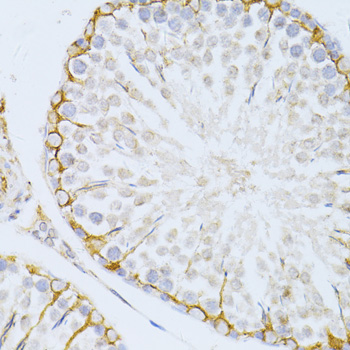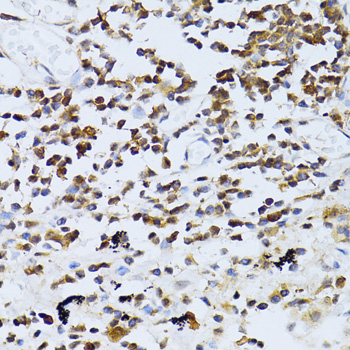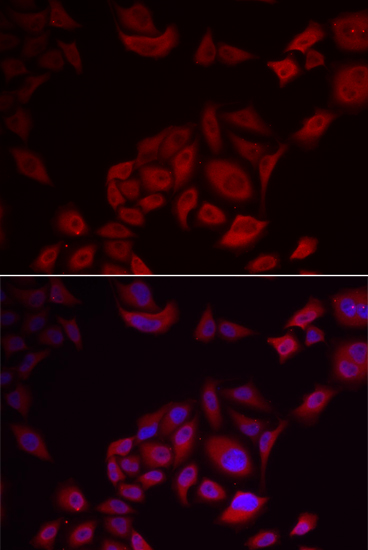Cell Biology Antibodies 10
Anti-PIKFYVE Antibody (CAB6689)
- SKU:
- CAB6689
- Product Type:
- Antibody
- Reactivity:
- Human
- Reactivity:
- Mouse
- Reactivity:
- Rat
- Host Species:
- Rabbit
- Isotype:
- IgG
- Antibody Type:
- Polyclonal Antibody
- Research Area:
- Cell Biology
Description
| Antibody Name: | Anti-PIKFYVE Antibody |
| Antibody SKU: | CAB6689 |
| Antibody Size: | 20uL, 50uL, 100uL |
| Application: | WB IHC IF |
| Reactivity: | Human, Mouse, Rat |
| Host Species: | Rabbit |
| Immunogen: | Recombinant fusion protein containing a sequence corresponding to amino acids 172-451 of human PIKFYVE (NP_689884.1). |
| Application: | WB IHC IF |
| Recommended Dilution: | WB 1:500 - 1:2000 IHC 1:50 - 1:100 IF 1:10 - 1:100 |
| Reactivity: | Human, Mouse, Rat |
| Positive Samples: | Mouse brain |
| Immunogen: | Recombinant fusion protein containing a sequence corresponding to amino acids 172-451 of human PIKFYVE (NP_689884.1). |
| Purification Method: | Affinity purification |
| Storage Buffer: | Store at -20'C. Avoid freeze / thaw cycles. Buffer: PBS with 0.02% sodium azide, 50% glycerol, pH7.3. |
| Isotype: | IgG |
| Sequence: | DLAW QSLI HPDS SNTP LSTR LVSV QEDA GKSP ARNR SASI TNLS LDRS GSPM VPSY ETSV SPQA NRTY VRTE TTED ERKI LLDS VQLK DLWK KICH HSSG MEFQ DHRY WLRT HPNC IVGK ELVN WLIR NGHI ATRA QAIA IGQA MVDG RWLD CVSH HDQL FRDE YALY RPLQ STEF SETP SPDS DSVN SVEG HSEP SWFK DIKF DDSD TEQI AEEG DDNL ANSA SPSK RTSV SSFQ STVD SDSA ASIS LNVE LDNV NFHI KKPS KYPH VPPH PADQ KGRR |
| Gene ID: | 200576 |
| Uniprot: | Q9Y2I7 |
| Cellular Location: | Endosome membrane |
| Calculated MW: | 50kDa/51kDa/61kDa/237kDa |
| Observed MW: | 280kDa |
| Synonyms: | PIKFYVE, CFD, FAB1, HEL37, PIP5K, PIP5K3, ZFYVE29 |
| Background: | Phosphorylated derivatives of phosphatidylinositol (PtdIns) regulate cytoskeletal functions, membrane trafficking, and receptor signaling by recruiting protein complexes to cell- and endosomal-membranes. Humans have multiple PtdIns proteins that differ by the degree and position of phosphorylation of the inositol ring. This gene encodes an enzyme (PIKfyve; also known as phosphatidylinositol-3-phosphate 5-kinase type III or PIPKIII) that phosphorylates the D-5 position in PtdIns and phosphatidylinositol-3-phosphate (PtdIns3P) to make PtdIns5P and PtdIns(3, 5)biphosphate. The D-5 position also can be phosphorylated by type I PtdIns4P-5-kinases (PIP5Ks) that are encoded by distinct genes and preferentially phosphorylate D-4 phosphorylated PtdIns. In contrast, PIKfyve preferentially phosphorylates D-3 phosphorylated PtdIns. In addition to being a lipid kinase, PIKfyve also has protein kinase activity. PIKfyve regulates endomembrane homeostasis and plays a role in the biogenesis of endosome carrier vesicles from early endosomes. Mutations in this gene cause corneal fleck dystrophy (CFD); an autosomal dominant disorder characterized by numerous small white flecks present in all layers of the corneal stroma. Histologically, these flecks appear to be keratocytes distended with lipid and mucopolysaccharide filled intracytoplasmic vacuoles. Alternative splicing results in multiple transcript variants encoding distinct isoforms. |
| UniProt Protein Function: | PIKFYVE: The PI(3,5)P2 regulatory complex regulates both the synthesis and turnover of phosphatidylinositol 3,5-bisphosphate (PtdIns(3,5)P2). Catalyzes the phosphorylation of phosphatidylinositol 3-phosphate on the fifth hydroxyl of the myo- inositol ring, to form phosphatidylinositol 3,5-bisphosphate. Required for endocytic-vacuolar pathway and nuclear migration. Plays a role in the biogenesis of endosome carrier vesicles (ECV)/ multivesicular bodies (MVB) transport intermediates from early endosomes. Defects in PIKFYVE are the cause of corneal fleck dystrophy (CFD). CFD is an autosomal dominant disorder of the cornea characterized by numerous small white flecks scattered in all levels of the stroma. Although CFD may occasionally cause mild photophobia, patients are typically asymptomatic and have normal vision. 4 isoforms of the human protein are produced by alternative splicing. |
| UniProt Protein Details: | Protein type:EC 2.7.1.150; Motility/polarity/chemotaxis; Kinase, lipid; Carbohydrate Metabolism - inositol phosphate Chromosomal Location of Human Ortholog: 2q34 Cellular Component: early endosome membrane; endosome membrane; Golgi membrane; late endosome membrane; lipid raft Molecular Function:1-phosphatidylinositol-4-phosphate 5-kinase activity; phosphatidylinositol-3,5-bisphosphate 5-phosphatase activity; protein binding Biological Process: phosphatidylinositol biosynthetic process; receptor-mediated endocytosis; retrograde transport, endosome to Golgi Disease: Corneal Dystrophy, Fleck |
| NCBI Summary: | Phosphorylated derivatives of phosphatidylinositol (PtdIns) regulate cytoskeletal functions, membrane trafficking, and receptor signaling by recruiting protein complexes to cell- and endosomal-membranes. Humans have multiple PtdIns proteins that differ by the degree and position of phosphorylation of the inositol ring. This gene encodes an enzyme (PIKfyve; also known as phosphatidylinositol-3-phosphate 5-kinase type III or PIPKIII) that phosphorylates the D-5 position in PtdIns and phosphatidylinositol-3-phosphate (PtdIns3P) to make PtdIns5P and PtdIns(3,5)biphosphate. The D-5 position also can be phosphorylated by type I PtdIns4P-5-kinases (PIP5Ks) that are encoded by distinct genes and preferentially phosphorylate D-4 phosphorylated PtdIns. In contrast, PIKfyve preferentially phosphorylates D-3 phosphorylated PtdIns. In addition to being a lipid kinase, PIKfyve also has protein kinase activity. PIKfyve regulates endomembrane homeostasis and plays a role in the biogenesis of endosome carrier vesicles from early endosomes. Mutations in this gene cause corneal fleck dystrophy (CFD); an autosomal dominant disorder characterized by numerous small white flecks present in all layers of the corneal stroma. Histologically, these flecks appear to be keratocytes distended with lipid and mucopolysaccharide filled intracytoplasmic vacuoles. Alternative splicing results in multiple transcript variants encoding distinct isoforms.[provided by RefSeq, May 2010] |
| UniProt Code: | Q9Y2I7 |
| NCBI GenInfo Identifier: | 300669693 |
| NCBI Gene ID: | 200576 |
| NCBI Accession: | Q9Y2I7.3 |
| UniProt Secondary Accession: | Q9Y2I7,Q08AR7, Q08AR8, Q53ST3, Q53T36, Q8N5H0, Q8NB67 |
| UniProt Related Accession: | Q9Y2I7 |
| Molecular Weight: | 61,595 Da |
| NCBI Full Name: | 1-phosphatidylinositol 3-phosphate 5-kinase |
| NCBI Synonym Full Names: | phosphoinositide kinase, FYVE-type zinc finger containing |
| NCBI Official Symbol: | PIKFYVE |
| NCBI Official Synonym Symbols: | CFD; FAB1; HEL37; PIP5K; PIP5K3; ZFYVE29 |
| NCBI Protein Information: | 1-phosphatidylinositol 3-phosphate 5-kinase |
| UniProt Protein Name: | 1-phosphatidylinositol 3-phosphate 5-kinase |
| UniProt Synonym Protein Names: | FYVE finger-containing phosphoinositide kinase; PIKfyve; Phosphatidylinositol 3-phosphate 5-kinase type III; PIPkin-III; Type III PIP kinase |
| UniProt Gene Name: | PIKFYVE |
| UniProt Entry Name: | FYV1_HUMAN |
View AllClose










